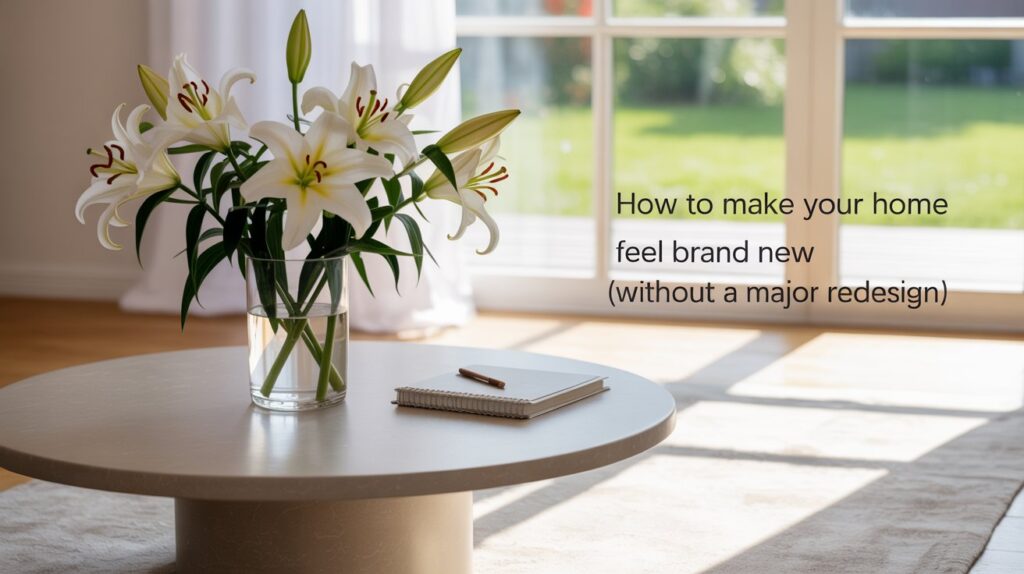A home doesn’t need a total renovation to feel refreshed. Often, small and thoughtful updates can transform your space, giving it a sense of newness and energy without the high cost or disruption of remodeling.
From reorganizing rooms to improving lighting and adding new textures, subtle changes can completely shift how a home looks and feels.
The key lies in focusing on manageable projects that improve comfort, appearance, and flow. By working with what you already have-and making strategic adjustments-you can give your home a modern, revitalized look that feels brand new.
Start with a Deep Clean and Declutter
Before making any visual updates, it’s best to start with a clean slate. Deep cleaning helps reveal your home’s true potential and highlights areas that might need attention. Decluttering also frees up space, making rooms feel more open and organized.
Even simple routines can make a big difference. Cleaning high-traffic areas, wiping baseboards, and freshening up surfaces can instantly change a room’s atmosphere.
Bathrooms, in particular, benefit from consistent upkeep. Using a toilet cleaning sheet is a quick and convenient way to keep fixtures spotless between deeper scrubs, helping your bathroom maintain that just-cleaned look without daily effort.
Decluttering, meanwhile, goes beyond tidying up. Studies show that a clutter-free environment can reduce stress and improve focus. Whether you donate unused items or reorganize your storage spaces, simplifying what you own often makes your home feel lighter and more welcoming.
Refresh Surfaces with Paint and Texture
One of the easiest ways to breathe new life into your home is with a fresh coat of paint. Even repainting one wall or a few trim areas can completely alter the tone of a space. Light, neutral colors tend to make rooms feel larger and brighter, while deeper shades can add warmth and character.
In addition to paint, consider adding texture through fabrics and finishes. Throw pillows, rugs, and curtains offer affordable ways to experiment with color and tactile contrast. For an elevated touch, natural materials like linen, cotton, and wood bring softness and authenticity that artificial finishes can’t replicate.
If repainting walls isn’t an option, smaller updates-like refinishing furniture or painting cabinet doors-still make a noticeable impact. A few well-chosen design elements can give even an older space a modern, cohesive look.
Let in More Natural Light
Light has one of the most powerful effects on how we experience space. Maximizing natural light can instantly make a home feel bigger, cleaner, and more vibrant. Start by checking window coverings-heavy curtains or blinds can block valuable sunlight.
Swapping them for lighter fabrics or sheer materials enhances brightness without sacrificing privacy.
Mirrors are another simple but effective tool. When placed strategically, they reflect both natural and artificial light, amplifying the sense of openness. Positioning mirrors across from windows or lamps can dramatically brighten darker rooms.
Update Fixtures and Hardware
Small hardware details-like cabinet knobs, faucets, and door handles-often go unnoticed, but replacing them can transform a space. Choosing finishes such as brushed nickel, matte black, or antique brass instantly modernizes a kitchen or bathroom.
Light fixtures are another high-impact, low-cost improvement. Swapping out a dated ceiling light for a modern pendant or statement fixture makes a big visual difference. Wall sconces or under-cabinet lighting in kitchens can also enhance function and mood without requiring major rewiring.
Reimagine Your Furniture Layout
Sometimes, making a home feel brand new doesn’t mean adding anything-it means rethinking what’s already there. Rearranging furniture can dramatically change the flow and perception of a room.
Start by focusing on function: how do you actually use each space, and can the layout better support those activities?
Try pulling furniture away from walls to create conversation zones or cozy nooks. Using area rugs can help define spaces within open-concept layouts. According to interior designers, even shifting the orientation of a sofa or bed can refresh a room’s balance and energy.
Incorporate Greenery and Natural Elements
Indoor plants are one of the simplest ways to make any space feel alive. They improve indoor air quality and add vibrant color and texture.
Even a few potted plants or a small herb garden in the kitchen can lift a room’s appearance. For low-maintenance options, consider succulents or faux greenery that requires minimal care but provides the same visual benefit.
Maintain the New Feel Over Time
Once your home feels refreshed, consistency is key to keeping it that way. Regular maintenance-like dusting surfaces, vacuuming rugs, and cleaning windows-preserves the sense of order and cleanliness.
Establishing weekly or monthly mini-tasks prevents chores from piling up. For example, cleaning kitchen appliances one week and checking HVAC filters the next spreads effort evenly throughout the year. This approach not only saves time but also extends the lifespan of your upgrades and furnishings.
Rediscovering Joy in Your Space
Transforming your home doesn’t always require new walls or expensive materials-it often starts with intention and awareness. When you pay attention to light, color, cleanliness, and comfort, your home naturally evolves into a place that supports your daily life.
By focusing on thoughtful updates instead of drastic changes, you can fall in love with your home all over again, one room at a time.

